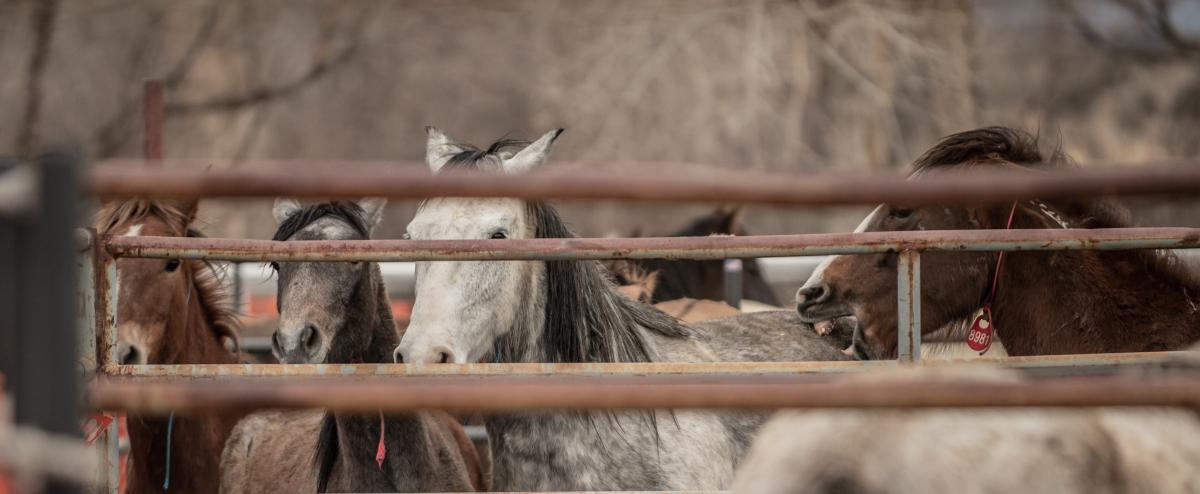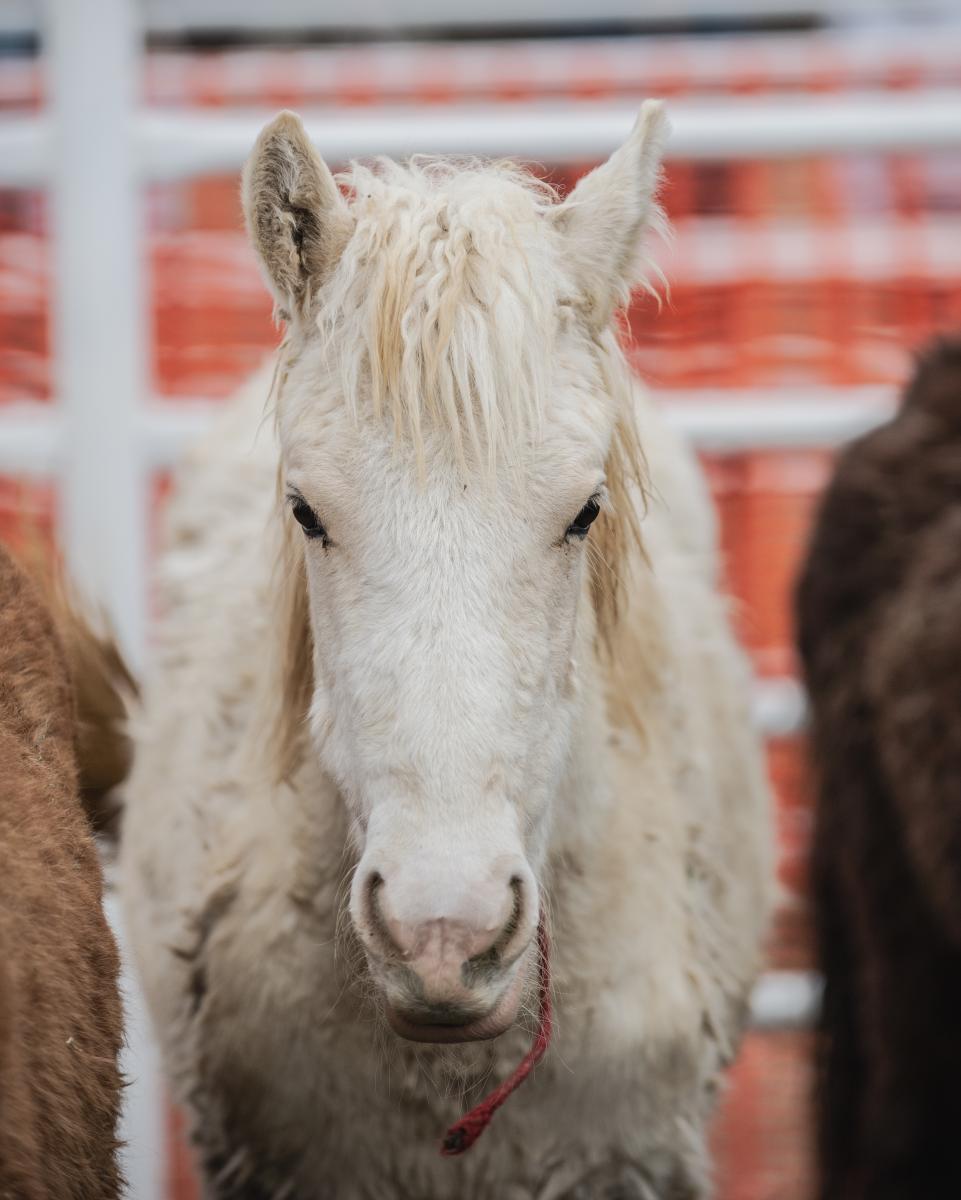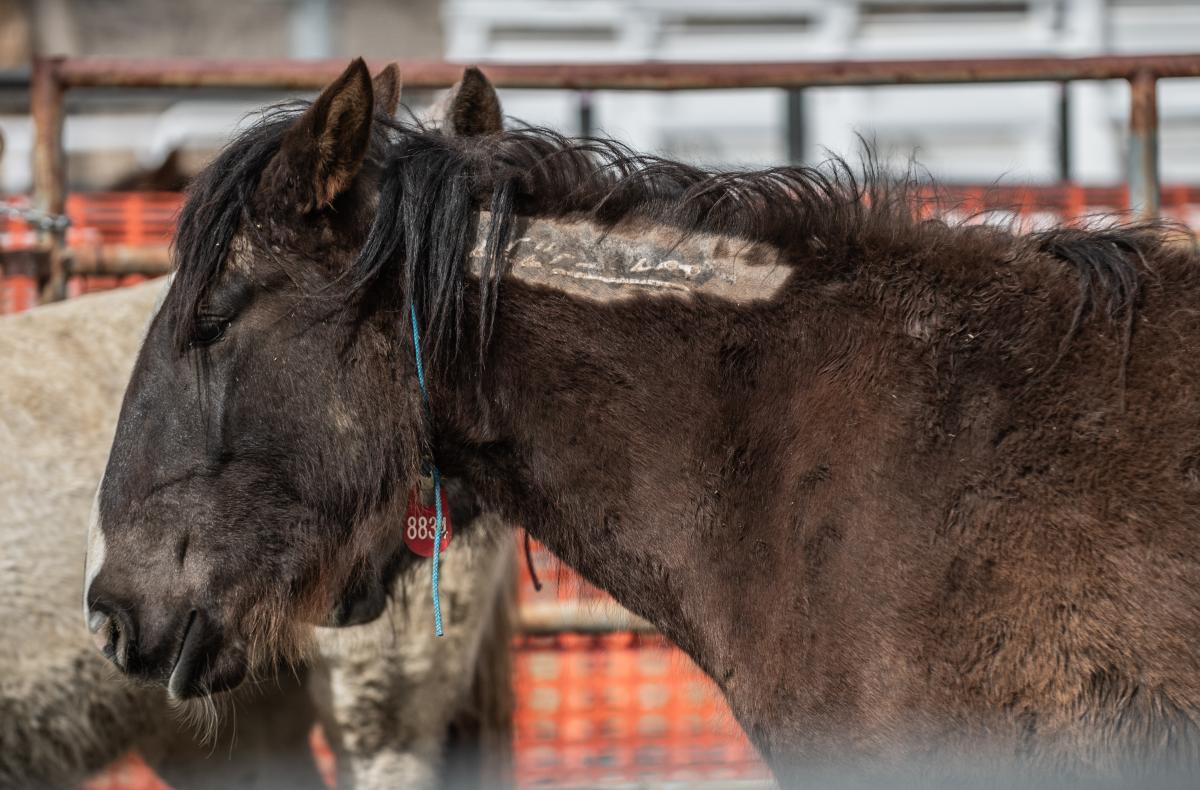By Amy Hadden Marsh
(March 14, 2022) Proud grandson of world-famous Picasso of the Sand Wash Basin herd, Michelangelo, was a celebrity horse at the Bureau of Land Management’s Sand Wash Adoption Event in Florence, Colorado on March 5 and 6. In an apparent bidding war among wildlife and mustang sanctuaries and rescues, top bidder Wildlife Animal Sanctuary (WAS) in Keenesburg, CO paid a whopping $14,000 for the mustang. WAS also paid close to $9500 for the mare Desiree. AWHC does not know why WAS – new to the wild horse protection cause – paid such a high price. Pat Craig, founder and director of WAS, has not returned AWHC’s requests for comment, but he did tell the Steamboat Pilot that the horses will be housed at WAS’ sanctuary property near Boulder pending a plan to purchase 50,000 acres in southern Colorado for a wild horse sanctuary.
 Photo by Scott Wilson.
Photo by Scott Wilson.
The good news is that none of the 73 horses offered at the auction returned to BLM holding pens. According to the Sand Wash Basin Wild Horse Advocacy Team (SWAT), 29 went to private adopters. Thirty-nine horses went to nonprofits and sanctuaries, including Windwalker Ridge in Missouri, Rocky Mountain Mustang in Fairplay, CO, the Animal Sanctuary in Keenesburg, CO, For the Love of Aria in Elizabeth, CO (FLA), Wild Rose Mustang Advocacy, Steadfast Steeds, and Bandita's. Four horses went to TIP trainers.
One mare died while the horses were being sorted and loaded into trailers. Stormie had been adopted by FLA. Gina Kuttrus, FLA founder, told AWHC that the mare died instantly after she ran into a gate and broke her neck. “She was not being pushed by any human,” explained Kuttrus. “She turned quickly and just hit the panels wrong.” Kuttrus said it was a “freak accident” and does not blame anyone for what happened. “The support from the vet and BLM staff was amazing,” she said. “They let us touch her and say goodbye for as long as we needed as well as gave us pieces of her mane.”
Another horse fell, got its head stuck in the fence, and was trampled by another mustang. “The horse was in the pen with 4 other horses,” said Chris Maestas, BLM Public Information Officer. “It was moving away from another horse when it slipped and fell, becoming entangled in a panel.” He added that BLM helped the horse to its feet and found no significant injuries.

Photo by Scott Wilson.
Maestas also said that more than 100 people attended the event and the crowd could have agitated the mustangs. An anonymous video shows the horse down and a BLM employee telling people to back away from the pens.
The injury and death in Florence are, indeed, tragic. And, as far as we can tell, accidental. But, how many more wild horses have to die as result of human contact? How much death will we accept as a necessary evil of mustang management?
And, how did we get to a place where sanctuaries are in bidding wars over one horse instead of working together to ensure that all horses at any event find homes? No horses at the Florence event were sold under the sale authority clause for $25, but who’s to say that older horses sold at the end of these events - and whose buyers get title on the spot - don’t go to other auctions and end up at a slaughterhouse?
Scott Wilson, photographer and AWHC board member, said the death of the horse is a result of a broken system and a lack of commitment from lawmakers. “We need better policy protections for wild horses where they belong - on public lands,” he said.
 Last September, during the roundup that caused these horses to be hauled to Canon City holding and then around the state to various adoption events, Colorado Governor Jared Polis, First Gentleman Marlon Reis, and Congressman Joe Neguse (D-CO) wrote letters to Nada Wolff Culver, the acting director of Colorado BLM and US Interior Secretary Deb Haaland, calling for a change in wild horse management. Photo at right, by Scott Wilson.
Last September, during the roundup that caused these horses to be hauled to Canon City holding and then around the state to various adoption events, Colorado Governor Jared Polis, First Gentleman Marlon Reis, and Congressman Joe Neguse (D-CO) wrote letters to Nada Wolff Culver, the acting director of Colorado BLM and US Interior Secretary Deb Haaland, calling for a change in wild horse management. Photo at right, by Scott Wilson.
“I urge you to temporarily freeze any planned roundups with the hope that a better outcome and better communication with stakeholders can be achieved, and potential opportunities for state engagement can be more fully explored,” wrote Polis. “Specifically, I encourage you to establish an immediate 6-month moratorium on roundups or long enough to ensure thorough stakeholder engagement to allow for a more thoughtful and inclusive process.”
Neguse also asked for a moratorium on roundups to give space for dialogue. Not unlike calling for a ceasefire to make room for negotiations.
These letters sent a message of hope to those concerned about the fate of the Sand Wash Basin herd, the target of Colorado’s largest roundup ever. The BLM ended the roundup early with a commitment by the agency to work with the Governor’s office and with stakeholders on developing a different path in Colorado. AWHC looks forward to participating in that conversation under the leadership of First Gentleman Reis.
 Meanwhile, Congress’ appropriations bill for FY22 calls for an interagency task force to discuss what agencies call “the crisis of wild horse overpopulation.” It also allocates $21 million more for roundups and removals than FY21. Photo at left by Scott Wilson.
Meanwhile, Congress’ appropriations bill for FY22 calls for an interagency task force to discuss what agencies call “the crisis of wild horse overpopulation.” It also allocates $21 million more for roundups and removals than FY21. Photo at left by Scott Wilson.
On the positive side, up to $11 million must go to fertility control research and treatment - the first time Congress has mandated that the BLM utilize fertility control to begin a shift away from roundups as the agency’s primary management tool.
At the same time, the BLM continues its plans to take more than 20,000 mustangs and burros from the range through September, 2022. The next Sand Wash Basin herd adoption event is at the Routt County Fairgrounds in Hayden, CO on May 20 and 21.


